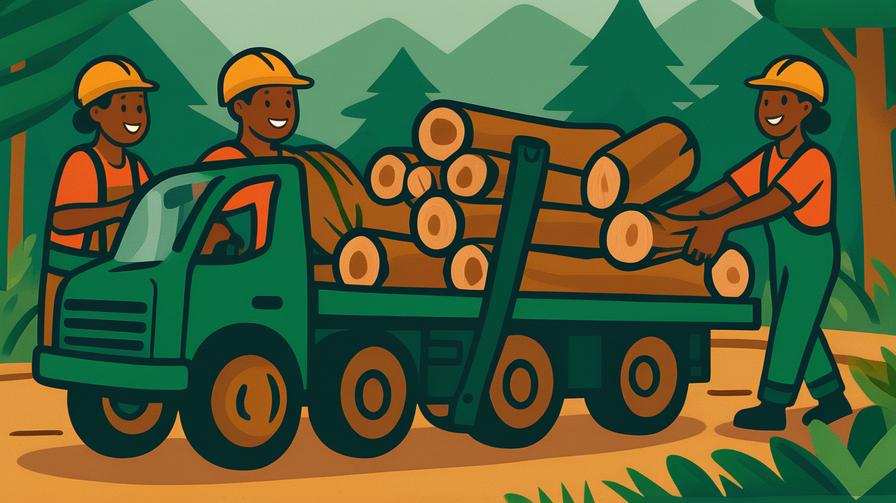[Disclaimer] This article is reconstructed based on information from external sources. Please verify the original source before referring to this content.
News Summary
The following content was published online. A translated summary is presented below. See the source for details.
Illegal timber trafficking is devastating forests across Central and East Africa, with criminal networks operating sophisticated smuggling routes from the Democratic Republic of Congo through Uganda to Kenya and beyond. This illicit trade, worth billions of dollars annually, involves cutting protected hardwood species like mahogany, teak, and rosewood from Congo’s rainforests and national parks. The timber is then transported through porous borders, often with help from corrupt officials, before being exported to international markets in Asia and Europe. Local communities report armed groups controlling logging areas, forcing residents to participate or face violence. Environmental scientists warn that current deforestation rates could eliminate Congo Basin forests within 50 years, destroying habitat for endangered species like forest elephants and great apes. The trafficking networks use similar routes and methods as wildlife smugglers, often combining illegal timber with ivory and bushmeat shipments. Despite international agreements and local laws prohibiting unauthorized logging, weak enforcement and high profits continue driving this environmental crime.
Source: Global Voices
Our Commentary
Background and Context

The Congo Basin contains the world’s second-largest tropical rainforest after the Amazon, covering 3.7 million square kilometers across six countries. These forests have existed for 10 million years and host incredible biodiversity – 10,000 plant species, 1,000 bird species, and 400 mammal species. They also store an estimated 60-80 billion tons of carbon, making them crucial for fighting climate change.
Timber trafficking isn’t new but has intensified dramatically since 2010 as Asian demand for luxury hardwoods skyrocketed. Criminal syndicates realized that trafficking timber carries lighter penalties than drug smuggling while generating similar profits. A single container of rosewood can sell for $1 million in China.
Expert Analysis
Environmental crime experts identify timber trafficking as the world’s third-largest illegal trade after drugs and weapons, generating $50-150 billion annually. In Africa, weak governance and corruption enable this trade. Border guards earning $100 monthly can be bribed with amounts that seem small to traffickers but represent months of salary to officials.
The sophistication of trafficking networks surprises many observers. Criminals use satellite phones, GPS tracking, and fake documentation. They employ lawyers, accountants, and shipping experts. Some operations resemble legitimate businesses, complete with offices and employee benefits. This professionalization makes enforcement extremely difficult.
Additional Data and Fact Reinforcement
The environmental impact extends beyond tree loss. Each year, Central Africa loses forest area equivalent to 5,000 football fields daily. Illegal logging roads open previously inaccessible areas to poachers, who kill 30,000 elephants annually for ivory. Local communities lose resources they’ve sustainably managed for generations – medicinal plants, food sources, and building materials.
Economic losses are staggering. African governments lose an estimated $17 billion annually in timber revenues to trafficking. Legal forestry operations, which follow sustainable practices and pay taxes, cannot compete with illegal operators who ignore all regulations. This drives legitimate businesses out, further reducing government income and legal employment.
Related News
International efforts to combat timber trafficking are increasing but face challenges. The European Union implemented regulations requiring companies to prove timber legality, but enforcement remains weak. China, the largest importer, recently banned illegal timber imports but struggles with verification.
Technology offers hope. Satellite monitoring can detect illegal logging in near real-time. DNA testing can trace timber origins, making false documentation harder. Some African countries are exploring blockchain systems to track legal timber from forest to export. Kenya launched drone patrols in 2024, reducing illegal logging by 30% in monitored areas.
Summary

Timber trafficking represents an environmental and economic catastrophe for Africa. Criminal networks destroy irreplaceable forests while robbing countries of needed revenue and communities of their resources. Without immediate action combining technology, enforcement, and international cooperation, Africa’s great forests could vanish within our lifetime, taking countless species and climate stability with them.
Public Reaction
Local communities express frustration at being caught between criminal gangs and poverty. Many participate in illegal logging not from choice but desperation, needing income to feed families. Environmental activists face death threats for exposing trafficking routes. Urban Africans increasingly connect deforestation to water shortages and extreme weather in cities. International consumers are beginning to demand certified sustainable timber.
Frequently Asked Questions
Q: How can students help stop timber trafficking?
A: Check if wooden products have sustainability certification, support organizations fighting illegal logging, and spread awareness about the issue. Choose products made from bamboo or recycled materials when possible.
Q: Why don’t governments just stop the trafficking?
A: Many factors complicate enforcement: vast forest areas, limited resources, corruption, and poverty that makes illegal logging attractive to desperate communities. International cooperation is essential but challenging.
Q: What happens when the forests disappear?
A: Loss of rainfall would turn farmland to desert, extinct species can never return, stored carbon releases accelerating climate change, and millions of people lose their traditional ways of life.


